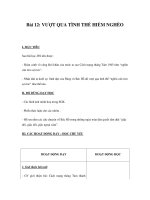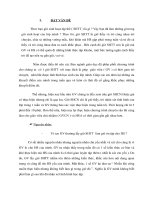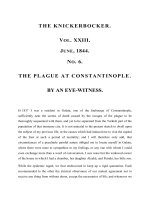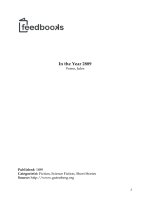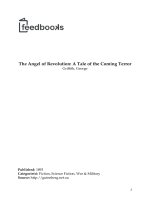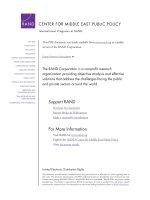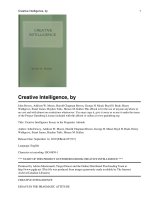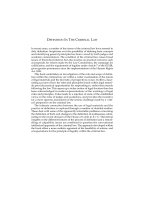The Persian Gulf in the Coming Decade docx
Bạn đang xem bản rút gọn của tài liệu. Xem và tải ngay bản đầy đủ của tài liệu tại đây (470.28 KB, 94 trang )
Daniel L. Byman • John R. Wise
Prepared for the
United States Air Force
Approved for Public Release; Distribution Unlimited
R
Project AIR FORCE
The Persian Gulf
in the Coming
Decade
Trends, Threats, and Opportunities
The research reported here was sponsored by the United States Air
Force under Contract F49642-01-C-0003. Further information may
be obtained from the Strategic Planning Division, Directorate of
Plans, Hq USAF.
RAND is a nonprofit institution that helps improve policy and
decisionmaking through research and analysis. RAND
®
is a
registered trademark. RAND’s publications do not necessarily reflect
the opinions or policies of its research sponsors.
© Copyright 2002 RAND
All rights reserved. No part of this book may be reproduced in any
form by any electronic or mechanical means (including
photocopying, recording, or information storage and retrieval)
without permission in writing from RAND.
Published 2002 by RAND
1700 Main Street, P.O. Box 2138, Santa Monica, CA 90407-2138
1200 South Hayes Street, Arlington, VA 22202-5050
201 North Craig Street, Suite 202, Pittsburgh, PA 15213-1516
RAND URL: />To order RAND documents or to obtain additional information,
contact Distribution Services: Telephone: (310) 451-7002;
Fax: (310) 451-6915; Email:
Library of Congress Cataloging-in-Publication Data
Byman, Daniel, 1967–
The Persian Gulf in the coming decade : trends, threats, and opportunities /
Daniel L. Byman, John R. Wise.
p. cm.
“MR-1528.”
Includes bibliographical references (p.).
ISBN 0-8330-3206-2
1. Persian Gulf Region. 2. Persian Gulf Region—Relations—United States.
3. United States—Relations—Persian Gulf Region. I. Wise, John R. II. Title.
DS326 .B96 2002
953.6—dc21
2002026577
Cover design by Stephen Bloodsworth
iii
PREFACE
This report examines likely challenges to U.S. interests in the Persian
Gulf region in the coming decade. In particular, the report explores
the conventional military strength of Iran and Iraq, the potential for
subversion, and the social and economic weaknesses of all the re-
gional states. In addition, it seeks to identify key uncertainties and
trends that may shape the region’s future. It then assesses the impli-
cations of these trends for the United States, particularly the U.S.
military.
The research was completed before the September 11, 2001 terrorist
attacks on the United States. These attacks had profound implica-
tions not only for America but also for the countries of the Persian
Gulf. This report does not address the ramifications of these attacks
and the U.S. response; the U.S. campaign is still unfolding and the is-
sues are the subject of current RAND research.
The project was sponsored by the Director of Operational Plans
Office of the Deputy Chief of Staff for Air and Space Operations (HQ
USAF/XOX) and took place in the Strategy and Doctrine Program of
RAND’s Project AIR FORCE. Comments are welcomed and may be
addressed to the Program Director, Dr. Ted Harshberger.
PROJECT AIR FORCE
Project AIR FORCE, a division of RAND, is the Air Force federally
funded research and development center (FFRDC) for studies and
analysis. It provides the Air Force with independent analysis of pol-
icy alternatives affecting the development, employment, combat
iv The Persian Gulf in the Coming Decade: Trends, Threats, and Opportunities
readiness, and support of current and future aerospace forces.
Research is performed in four programs: Aerospace Force
Development; Manpower, Personnel, and Training; Resource
Management; and Strategy and Doctrine.
v
CONTENTS
Preface iii
Figures vii
Tables ix
Summary xi
Acknowledgments xvii
Chapter One
INTRODUCTION 1
U.S. Interests in the Gulf Region 2
Potential Threats to Interests 6
Structure and Research Approach 8
Chapter Two
THE DECLINING CONVENTIONAL THREAT FROM IRAN
AND IRAQ 11
The Shifting Military Balance 12
Iraq’s Limited Conventional Military Capabilities 12
The Uncertain Future of Sanctions 16
Continued Iranian Weakness 19
The Future Military Threat from Iran and Iraq: Key
Uncertainties 26
The Pace of Rebuilding 26
The Direction of Any Buildup 28
A Shift Toward WMD? 30
Gulf Partners 32
Strengths 32
vi The Persian Gulf in the Coming Decade: Trends, Threats, and Opportunities
Weaknesses 36
The Dominant U.S. Position 40
A Decline in Subversion 43
Chapter Three
INTERNAL THREATS TO REGIONAL PARTNERS 47
The Fraying Social Contract 47
Growing Stagnation and Reform 47
Economic Problems Common to the Gulf States 48
Limited Momentum for Reform 52
Impact on the Social Contract? 52
How the U.S. Presence and Policy Increase
Challenges 53
Opposition to U.S. Policy in the Middle East 55
Dramatic Regime Change in Iraq or Iran 55
Chapter Four
CONCLUSIONS 59
The Shifting Challenge 59
The Conflicting Security Dynamics of the Oil Market 60
Looking Outside the Middle East 63
Anticipating Instability Within U.S. Adversaries 64
Preparing for Anti-U.S. Pressure Among Partners 64
Final Words 66
Appendix : MILITARY STRENGTH IN THE GULF STATES 67
Bibliography 75
vii
FIGURES
2.1. Iraqi, Iranian, and Gulf States’ “Quality” Main Battle
Tanks 35
2.2. Iraqi, Iranian, and Gulf States’ “Quality” Combat
Aircraft 36
A.1. Gulf States’ “Quality” Main Battle Tanks 72
A.2. Gulf States’ “Quality” Combat Aircraft 73
ix
TABLES
1.1. Past Challenges to U.S. Interests in the Gulf 6
2.1. Origins of Iraqi Military Platforms 14
2.2. Iraqi and Kuwaiti Military Assets 17
2.3. Origins of Iranian Military Platforms 22
2.4. Iranian Air Transport 24
2.5. Distance from Iranian Airfields to Gulf Capitals 24
2.6. Iran’s Naval Assets 25
2.7. Gross Military Measures for Iran, Iraq, and the Gulf
States 32
2.8. Gulf State Selected Military Purchases, 1991–2000 34
2.9. Naval Surface Assets in the Gulf 37
2.10. Population of Eligible Military Recruits 38
A.1. Gross Measures of Military Strength in the Gulf 68
A.2. Combat Units in the Gulf 69
xi
SUMMARY
The war and instability that have long characterized the Persian Gulf
have diminished in the last decade—a shift that calls for a reevalua-
tion of U.S. policy. The conventional military threat to U.S. partners
has lessened. However, the Gulf regimes, while generally stable, may
face increased popular pressure to curtail ties to the United States,
particularly to the U.S. military.
THE DANGER IN THE PAST
The United States and its partners in the Gulf region have faced a
range of challenges over the last 25 years. Iraq invaded Kuwait in
1990 and, after being expelled by a massive coalition military effort,
has continued to threaten the security of U.S. partners in the region.
In 1971, Iran occupied several islands claimed by the United Arab
Emirates (UAE). It has since increased its military presence on the
islands and has even deployed chemical weapons there during crises.
Iran and Iraq’s rivalry with each other has at times spilled outside
their borders, leading them to bully or subvert U.S. regional partners.
Internal instabilities have also posed a threat to U.S. partners. Iran
and Iraq both sponsored terrorism in the Gulf, with Tehran in
particular engaged in a range of efforts to overthrow the conservative
Gulf monarchies. Islamists in Saudi Arabia have used violence
against the regime and U.S. forces. Bahrain suffered widespread
communal rioting and unrest in the mid-1990s, as Bahraini Shi’a
xii The Persian Gulf in the Coming Decade: Trends, Threats, and Opportunities
protested against discrimination and demanded a greater voice in
decisionmaking.
1
THE SHIFTING MILITARY BALANCE
The military balance in the Gulf is far more favorable to the United
States and its partners than it was in the past. Iraq’s military is
weaker in both absolute and relative terms than it was in 1990. Iraqi
forces have never recovered from the battering they took from the
U.S led coalition in Operation Desert Storm. Sanctions have pre-
vented Iraq from importing significant numbers of weapons or up-
grading existing systems. Iraqi morale is low, and the officer ranks
are heavily politicized.
As a result, it is questionable whether Iraq can initiate, let alone
sustain, conventional operations involving more than a few
divisions. However, given the proximity of Kuwait to Iraq, the small
size of Kuwaiti forces, and the favorable terrain, Iraq could overrun
Kuwait if U.S. forces were not present. Baghdad could also deploy
several divisions against Jordan, Syria, Iran, and Turkey.
Iraq’s ability to rebuild its conventional military forces and revitalize
its economy depends heavily on whether sanctions are lifted and
what, if any, restrictions remain on the regime. Iraq’s weapons of
mass destruction (WMD) expertise and programs are considerable
and, if sanctions were lifted, the country could gain a nuclear
capacity within several years. Another priority for Iraq is to rebuild
its chemical, biological, and missile systems.
Iran poses even less of a conventional military threat to the Gulf
states than does Iraq. Although Tehran has faced fewer restrictions
on its military purchases than has Baghdad in the last decade, its ini-
tial military position was far weaker. Iran has not fully recovered
______________
1
The September 11, 2001 terrorist attacks had a profound impact on the Gulf region
and on U.S. relations with the Middle East more broadly. The attacks strongly affect
U.S. relations with Saudi Arabia and other states whose citizens have provided
financial support for and manpower to radical causes. In addition, the U.S. response
has considerable implications for the stability of friendly regimes. Nevertheless, this
report does not address these issues; the ramifications from the attack and from the
subsequent U.S. campaign against terrorism are still unfolding and are the subject of
current RAND research.
Summary xiii
from the Iran-Iraq war, which killed hundreds of thousands of Irani-
ans and destroyed much of Iran’s military equipment. The war also
created widespread opposition to military adventurism in general
among the Iranian people. Iran’s military lacks a dependable sup-
plier, and its budget has been limited in the last decade, although in-
creases in oil prices in the past two years have provided more cur-
rency for arms purchases. In addition, Tehran would need far
greater capabilities to pose a conventional military threat to the Gulf
states because of geography: Iranian forces must conduct amphibi-
ous operations across the Persian Gulf or go through Iraqi territory,
either of which would be difficult and exponentially more challeng-
ing than an Iraqi invasion of Kuwait.
In addition to decreased danger of outright invasion, the threat of
Iranian-backed subversion has also fallen in the last decade. Since
the mid-1990s, Iran has become far less active in promoting unrest in
the Gulf. Tehran has cultivated the goodwill of the Gulf states to
improve cooperation in oil pricing and, in general, pursues a less
aggressive regional foreign policy. Perhaps most important, the
attraction of the Iranian revolution has declined in the Gulf, reducing
the number of potential supporters.
Iran still poses a range of potential threats to U.S. interests. Iran
could use its clandestine network to subvert an already unstable Gulf
state. It could use its limited forces to temporarily deny commercial
shipping access to the Gulf. Finally, Iran could seize an island in the
Gulf claimed by a U.S. ally or an offshore oil platform. Iran, like Iraq,
has pursued a range of WMD programs and it might develop a
nuclear weapon in the coming decade.
In addition to the weakness of likely adversaries, the United States
has dramatically increased its regional military presence and overall
capacity to respond to contingencies. On average, the United States
deploys 25,000 personnel in the Gulf region. In addition to the forces
it has in the theater, the United States has augmented its cooperation
with the Gulf states and its ability to respond rapidly.
MARGINALLY STRONGER GULF PARTNERS
The military balance is increasingly favorable for the United States
not only because of the weakness of Iran and Iraq, but also because
xiv The Persian Gulf in the Coming Decade: Trends, Threats, and Opportunities
of the increased relative strength of its Gulf partners. Given the size
of their militaries, the amount of advanced equipment the Gulf states
have purchased since the Gulf War is staggering; it includes pur-
chases of state-of-the-art fighter aircraft, tanks, armored personnel
carriers, and other costly items. The Gulf states have also benefited
from closer cooperation with the U.S. military.
Despite the impressive capabilities of their military systems, the Gulf
partners would remain dependent on the United States in many
contingencies, particularly those involving an Iraqi invasion of
Kuwait or Saudi Arabia. The Gulf states’ military forces’ skills do not
match the capabilities of their sophisticated systems. Many of the
Gulf states face severe manpower shortages arising from the small
base of eligible recruits. Often the Gulf states do not have the neces-
sary support infrastructure for the systems they own. Training and
maintenance may be neglected or perfunctory. Regional land forces’
capabilities for maneuver warfare are poor, and they lack effective
combined arms and joint capabilities. Although several of the Gulf
states’ air forces are reasonably skilled at air-to-air operations, they
have few air-to-ground capabilities.
THE FRAYING SOCIAL CONTRACT
Although the external threats to U.S. interests are limited, the picture
is darker when the internal situation of U.S. partners is examined.
U.S. partners are not on the brink of revolution or dramatic regime
change, but it is likely that economic and social pressures will grow
in the coming decade, making it more difficult for these states to
cooperate openly and wholeheartedly with the United States.
A number of economic and social problems are undermining the
political arrangement that has governed social relations in the Gulf
since the discovery of oil. The Gulf states have failed to diversify their
economies beyond oil. As a result, in Saudi Arabia, Bahrain, and
Oman unemployment is growing and the government is less able to
provide the services that many Gulf citizens take for granted.
Burgeoning populations, poor education systems, and fluctuations
in the price of oil only exacerbate the economic problems.
Summary xv
Governments in the Gulf are under pressure to be responsive, and
the potential for unrest is growing. Gulf governments, however, have
not established effective political institutions for managing any
increased tension. Although these economic, social, and political
problems have not caused massive unrest and are not likely to do so,
they raise the prospect of greater criticism, limited unrest, and
increased tension.
KEY UNCERTAINTIES
Several hard-to-predict factors will shape the Gulf in the coming
decade. Iran and Iraq face the potential for massive and chronic
instability. A collapse of either regime, or even increased turmoil,
could lead to civil strife, refugee flows, and other forms of instability.
In addition, neighboring powers might meddle, and Iranian or Iraqi
leaders might try to divert domestic attention by becoming
aggressive abroad.
The quality of the conventional weapons that Iran and Iraq will pos-
sess will in large part be determined by Russia—a major supplier to
Iran—and Europe, which currently does not sell major systems to
either country. Whether Iran or Iraq will possess advanced surface-
to-air missiles and antiship cruise missiles, is trained to use various
sophisticated systems, and otherwise is able to acquire the capabili-
ties needed to challenge the United States will depend more on de-
cisions in Moscow or Paris than those in Baghdad or Tehran. During
the 1990s, the United States effectively limited the flow of advanced
weapons to Iran and to Iraq, but changes in U.S Europe or U.S
Russia relationships could lead to greater problems in the Gulf. The
cooperation of outside powers is particularly important to halt Iran
and Iraq’s WMD programs.
The price of oil is a key question, but the security dynamics of the oil
market are often contradictory. On the one hand, a higher oil price
will enable Iran and Iraq to purchase more weapons and otherwise
sustain their regimes in the face of domestic unrest. On the other
hand, a low oil price will hurt U.S. partners as well as adversaries, in-
creasing the risk of political instability in the region.
xvi The Persian Gulf in the Coming Decade: Trends, Threats, and Opportunities
PREPARING FOR ANTI-U.S. PRESSURE
The U.S. military presence and overall U.S. policy at times increase
domestic criticism of the Gulf regimes. Much of the public in the
Gulf believes their governments spend heavily on supporting U.S.
forces, money that they believe would otherwise be used to alleviate
economic hardship. The large U.S. military presence also highlights
the failure of area regimes to protect their citizens. Depending on
foreigners to provide security is particularly problematic because
Western political and religious values are often seen as incompatible
with Islamic teachings. This dilemma poses particular problems in
Saudi Arabia, whose religious establishment believes that Western
values are corrupting and should be kept out of the country.
Criticism of U.S. support for Israel is widespread, and many area
residents also believe that the United States seeks to perpetuate the
suffering of the Iraqi people.
The United States currently has achieved a balance between its mili-
tary requirements in the Gulf and the ability of regional partners to
host and work with U.S. forces. Nevertheless, if domestic unrest in-
creases, the Gulf states may face increased pressure to decrease ties
to the United States, particularly those with the U.S. military. Such
problems may make the operating environment difficult for the
United States. Possible problems include placing limits on U.S. op-
erations, responding slowly during a crisis, limiting support for vari-
ous U.S. political initiatives in the region, cutting military purchases,
and reducing the size or visibility of the U.S. military presence.
xvii
ACKNOWLEDGMENTS
Many people gave generously of their time and expertise, greatly
strengthening the conclusions in this report. Lt Colonel Michael
Davis, General Hugh Cameron (USAF, ret.), David Oemig, and
William King offered many insights into the complexities of the re-
gion and the resulting complications for U.S. military operations.
Geoffrey Kemp and Andrew Parasiliti provided thorough and
thoughtful reviews of this document. At RAND, Nora Bensahel,
Jerrold Green, Ted Harshberger, C. R. Neu, Jeremy Shapiro, and Alan
Vick offered many helpful suggestions and kindly served as a sound-
ing board for a range of ideas and arguments. Risha Henneman’s
administrative assistance was invaluable, as was that of Leslie
Thornton.
1
Chapter One
INTRODUCTION
War, revolution, unrest, and extremism have plagued the Persian
Gulf over the last 25 years. The Iranian revolution, the Iran-Iraq war,
a Shi’a Muslim coup attempt in Bahrain, riots and demonstrations in
Saudi Arabia, the U.S Iran naval clashes during the 1987–1988 re-
flagging effort, the Iraqi invasion of Kuwait, and the post–Gulf War
aggressive containment of Iraq and Iran are only the most visible
troubles. Understandably, U.S. policy has focused on defending its
partners in the region from the twin threats of military aggression
and foreign-backed subversion.
1
This report argues that strife and radicalism have obscured recent
trends toward regional stability—a shift that calls for a reevaluation
of U.S. policy. The Gulf states of Kuwait, Saudi Arabia, Oman,
Bahrain, Qatar, and the United Arab Emirates (UAE) are more secure
now than at any time since the fall of the Shah of Iran. Saddam
Husayn’s Iraq, while still aggressive, is for the moment defanged in a
conventional military sense. Reformers who are more pro-Western
and less bellicose in general are gaining power in Tehran. Iran and
Iraq’s conventional forces are weak as a result of import restrictions,
maintenance problems, growing obsolescence, poor training, and
______________
1
Although the September 11, 2001 terrorist attacks had a profound impact on the Gulf
region and on U.S. relations with the Middle East more broadly, the implications are
not addressed in this report. Clearly, the attacks strongly affect U.S. relations with
Saudi Arabia and other states whose citizens have provided financial support for and
manpower to radical causes. In addition, the U.S. response has considerable implica-
tions for the stability of friendly regimes. Nevertheless, this report does not address
these issues; the ramifications from the attack and from the subsequent U.S. campaign
against terrorism are still unfolding and are the subject of current RAND research.
2 The Persian Gulf in the Coming Decade: Trends, Threats, and Opportunities
limited budgets. Even without the formidable U.S. presence in the
region, the two countries pose little danger to their neighbors. The
ideological threat also is diminished. The Gulf states have weathered
Iranian-inspired and home-grown Islamist unrest, to the surprise of
many observers.
Indeed, it is U.S. adversaries, not U.S. partners, that are under siege.
The least stable governments in the region today are the noxious
regime of Saddam Husayn and the hard-line clerical cabal in Tehran.
Although Saddam retains a firm grip on power, he does not exercise
control over all of Iraq, let alone his neighbors. Unrest at home con-
tinues to simmer, as does ethnic and sectarian tension. Iran’s
“government of God” is also under siege, albeit a largely quiet one.
Since the election of Mohammed Khatami in 1997, Iran’s govern-
ment has slowly shifted its policies from confrontation to concilia-
tion. Yet stability may remain elusive. Even though oil prices rose
considerably at the end of the decade and in 2001, Iran’s economy
has stagnated, and politicians in Tehran may choose a bellicose for-
eign policy to divert domestic attention from the regime’s failures.
Many challenges to U.S. interests in the Gulf remain acute, but they
are of a different nature from the ones facing U.S. planners a decade
ago. Both Iran and Iraq are pursuing weapons of mass destruction
(WMD), and either could acquire conventional systems that would
make U.S. military operations more difficult. Gulf regimes, while
generally stable, may face increased popular pressure to curtail ties
to the United States, particularly those with the U.S. military.
Ignoring these changes may lead the United States to prepare for the
wrong threat or inadvertently destabilize the very partners it seeks to
protect.
U.S. INTERESTS IN THE GULF REGION
The Persian Gulf is a critical region for the United States for a num-
ber of reasons.
2
The most important U.S. interest is ensuring the free
______________
2
After the September 11, 2001 attacks, the suppression of terrorism has become the
primary U.S. concern in the region. The United States has a strong interest in ensuring
that Iran and Iraq do not sponsor terrorism against it or its U.S. allies. In addition, the
United States seeks to ensure that nationals in Saudi Arabia or other states in the
region do not join terrorist groups or provide them with financial or other assistance.
Introduction 3
flow of oil from the region to world markets. States in the Gulf will
remain leading oil exporters in the next decade, although the degree
of their dominance will depend heavily on the price of oil. Saudi
Arabia alone has more than a quarter of the world’s total proven re-
serves; Iraq has the second largest reserves, possessing over 10 per-
cent of the world’s total; while Iran, the UAE, and Kuwait have about
9 percent each.
3
By the end of the decade, Iraq’s sustainable pro-
duction capacity could easily double, and perhaps triple, with suffi-
cient foreign investment.
4
Several states in the region, including Saudi Arabia and Iraq, have ex-
ceptionally low production costs for extracting oil, allowing them to
make a profit even if the price of oil plunges.
5
Indeed, because ex-
traction costs are higher everywhere else in the world, the share of
the world market that Saudi Arabia and Iraq will enjoy is likely to be
far higher if the global price of oil is low.
6
Even limited instability in the oil market presents daunting problems
for industrial economies. Because it is hard to substitute other
commodities for oil quickly, oil demand declines slowly even in re-
sponse to exceptionally high prices. Oil prices skyrocketed 400 per-
______________
3
“BP Amoco Statistical Review of World Energy 2000,” available at http://www.
bpamaco.com/worldenergy/oil (accessed on March 5, 2001).
4
Although the potential remains for other parts of the world to develop large reserves,
many of these regions are plagued with problems that may prevent the full exploita-
tion of these resources. The Caspian region’s estimate of known reserves is roughly
comparable to those in the North Sea. Developing this energy, however, remains
problematic. Russia repeatedly interferes with international oil companies’ attempts
to sign agreements to export from and invest in Central Asia and often forces the
Central Asians to allocate energy to the states of the former Soviet Union at below-
market prices. Political turmoil, poor maintenance, and corruption also interfere with
attempts to develop Central Asia as a rival to the Gulf. The South China Sea and the
Tarim Basin also contain considerable reserves, though it appears that China may
have exaggerated the initial findings. Much of the South China Sea reserves are in ar-
eas disputed among China, Taiwan, Vietnam, the Philippines, Malaysia, and Brunei.
Because of these disputes, the size of the reserves and the cost of retrieving the oil re-
main uncertain.
5
/>iraq.html; and />6
The Gulf also has tremendous natural gas reserves. At the end of 1999, Iran pos-
sessed over 15 percent of the world’s total share of proven gas reserves, while Qatar,
Saudi Arabia, and the UAE control just under 15 percent. “BP Amoco Statistical
Review of World Energy 2000,” available at />naturalgas.
4 The Persian Gulf in the Coming Decade: Trends, Threats, and Opportunities
cent in 1973 and increased 150 percent and 50 percent respectively
in 1979 and 1990. Switching energy sources or reducing the use of
energy is difficult and takes time, making short-term disruptions of
vital consequence.
7
For example, if a crisis in the Middle East re-
sulted in a net shortfall of four million barrels of oil per day—around
6 percent of the world’s total consumption—it might cause the price
of oil to double in the short term, leading to disruption and possible
stagnation among leading advanced industrial economies.
8
Oil
shocks today, however, are less likely than in the past to cause
tremendous disruption because of greater market efficiency, pro-
ducer desires to create a stable market, latent production potential
from developed sources that are not tapped as a result of the high
cost of extraction, and government-held reserves.
In addition to ensuring the flow of oil from the Gulf region, the
United States also has an interest in preventing, or at least managing,
the spread of WMD. Their spread or use is opposed by the United
States more generally, even if they do not pose an immediate threat
to U.S. interests. Those weapons in the Gulf region pose a threat to
U.S. partners and U.S. forces. As discussed in greater detail below,
the Gulf region appears especially prone to WMD proliferation, and
perhaps even use. The Iran-Iraq war witnessed the repeated use of
chemical weapons by Iraq and their occasional use by Iran. Iraq also
possessed a vast biological weapons program and came close to de-
veloping a nuclear weapon, but the Persian Gulf War and subsequent
sanctions and inspection regimes cut these activities short. Iran has
pursued nuclear and biological weapons, although its programs lag
behind those of Iraq.
The United States also seeks to ensure the security of friendly
regimes. In the last decade, the United States has developed strong
and close relations to Saudi Arabia, Kuwait, the UAE, Bahrain, Qatar,
______________
7
Steven R. David, “Saving America from the Coming Civil Wars,” Foreign Affairs, Vol.
78, No. 1, January/February 1999, p. 112.
8
For total global consumption patterns, see />petroleum/analysis_publications/oil_market_basics/default.htm. For an explanation
of the economic impact of an oil price spike, see Edward R. Fried and Philip H. Trezise,
Oil Security: Retrospect and Prospect, Brookings Institution, Washington, D.C., 1993,
pp. 3, 76–77. A rise in the price of oil simultaneously creates recessionary and
inflationary pressures, posing a particularly difficult set of problems for policymakers
to overcome.
Introduction 5
and Oman.
9
Although these states’ possession of, or proximity to,
large oil reserves was the initial reason for U.S. efforts to build ties,
these relations have taken on a life of their own. It is not clear if the
United States would intervene with its own forces to keep these
regimes in power (in spite of much hand-wringing, Washington did
not intervene after revolution toppled the Shah of Iran). However,
the United States would almost certainly view any significant politi-
cal change with concern and in general it favors the status quo.
Finally, the United States’ broad, worldwide interest in democracy
and human rights has implications for U.S. actions in the Gulf region,
although this interest is honored more in the breach. Saudi Arabia,
for example, has no free press or free elections, and Saudi women
face a variety of restrictions on their travel, employment, and daily
lives. Even Kuwait, perhaps the most democratic of the Gulf states,
has a limit on who can vote, a ban on political parties, and other ba-
sic impediments to democracy.
10
These restrictions elicit only mild
criticism from Washington. As Jon Alterman notes, “American offi-
cials have tended to accede to official requests to downplay calls for
democratization and to shun extensive contacts with those working
against the ruling governments.”
11
Concerns over democratization and human rights, however, often
limit U.S. actions and could affect the type of support it would pro-
vide in a crisis. For example, if unrest in a Gulf state led to mass
______________
9
Many of these relationships became close well before 1990. The United States estab-
lished a defense cooperation agreement with Oman in 1980. Well before that, the
United States had an unwritten “handshake agreement” with Saudi Arabia, with U.S.
forces committed to defending the Kingdom’s security. See William Quandt, Saudi
Arabia in the 1980s: Foreign Policy, Security, and Oil, The Brookings Institution,
Washington, D.C., 1981; Joseph A. Kechichian, Oman and the World: The Emergence
of an Independent Foreign Policy, RAND, MR-680-RC, 1995, pp. 139–158; and Nadav
Safran, Saudi Arabia: The Ceaseless Quest for Security, Cornell University Press, Ithaca,
NY, 1988.
10
See Nora Bensahel, “Political Reform in the Middle East,” in Nora Bensahel and
Daniel Byman (eds.), Security Trends in the Middle East and Their Implications for the
United States, RAND, forthcoming.
11
Jon Alterman, “The Gulf States and the American Umbrella,” Middle East Review of
International Affairs, Vol. 4, No. 4, December 2000, electronic version. Reports that
the U.S. State Department was preparing a new program to promote political,
economic, and social reform (Peter Slevin and Glenn Kessler, “U.S. to Seek Mideast
Reforms; Programs Aim to Foster Democracy, Education, Markets,” Washington Post,
August 21, 2002) in the region appeared too late for evaluation in this study.
6 The Persian Gulf in the Coming Decade: Trends, Threats, and Opportunities
demonstrations and the government responded by killing large
numbers of unarmed protesters, the United States would have to re-
consider arms sales to the country and might otherwise limit ties at
least temporarily. In addition, even if unrest threatened the flow of
oil or the stability of a friendly regime, it is highly unlikely that the
United States would use its own forces to directly assist a regime re-
sponsible for torture, arbitrary arrests, and other forms of repression
widely condemned in the United States and the West in general.
Thus, human rights and democratization goals may inhibit U.S. at-
tempts to defend its other interests.
POTENTIAL THREATS TO INTERESTS
In recent decades, several different types of threats to U.S. interests
have emerged. Examples are presented in Table 1.1.
Table 1.1
Past Challenges to U.S. Interests in the Gulf
External Aggression
External Subversion or
Terrorism Internal Unrest
Iraqi invasion of Kuwait
(1990)
Iranian and Iraqi attacks
on Gulf tankers during
the Iran-Iraq war (1987–
1988)
Iraqi threats to Kuwait
(1994)
Iranian and Iraqi WMD
programs (ongoing);
Iranian seizure of Gulf
islands claimed by the
UAE (1971 and 1992)
Iranian support for Shi’a
radicals in the Gulf
(ongoing, particularly in
the 1980s)
Iranian support for 1981
coup attempt in Bahrain
Iranian efforts to capitalize
on Shi’a unrest in Bahrain
(1994–1996)
Iranian-affiliated radicals’
attempts to assassinate the
Emir of Kuwait (1985) and
terrorist attacks in Kuwait
City (1983)
Iranian-backed unrest at the
hajj
Radical seizure of the Grand
Mosque in Mecca (1979)
Shi’a riots in Bahrain,
Kuwait, and the Eastern
Province of Saudi Arabia
(1979–1981)
Radical attacks on U.S.
forces in Saudi Arabia
(1995)
Shi’a unrest in Bahrain
(1994–1996)
Introduction 7
The greatest danger in the past was outright aggression by Iran or
Iraq. In the 1970s, the two states fought a proxy war over the Shatt
al-Arab waterway. Iran and Iraq fought a brutal eight-year war with
each other in the 1980s, leading to disruptions in the flow of oil and
destabilizing the region. Relations in the 1990s remained tense—
both sides supported terrorists in the other’s country and otherwise
sought to destabilize each other.
Iran and Iraq have threatened U.S partners in the Gulf as well as each
other. Iraq invaded Kuwait in 1990 and was only expelled by the
U.S led coalition’s massive military effort. Since then, Iraq has re-
peated its view that Kuwait is an integral part of Iraq. Baghdad has
built up troops near the Kuwait border and made numerous threats
against Kuwait, Saudi Arabia, and other regional states.
12
Iran, particularly in recent years, has been less threatening to the
Gulf states than Iraq, but nevertheless has regularly shown aggressive
intentions. In 1971, Iran occupied several islands claimed by the
UAE. After the Iranian revolution in 1979, Iranian leaders regularly
called for the overthrow of Gulf rulers. Tehran backed a coup at-
tempt in Bahrain and supported terrorism in Kuwait and Saudi
Arabia.
In its war with Iraq, Iran tried to coerce Kuwait and other regional
states into halting their support for Iraq by attacking their shipping,
particularly their oil tankers. During the anti-regime demonstrations
in Bahrain between 1994 and 1996, Iran tried to take advantage of the
unrest by training and supporting Shi’a radicals. Since the mid-
1990s, however, Iran has toned down its rhetoric toward its Gulf
neighbors and sought to improve ties.
Internal instability also poses a threat to U.S. interests. Political
Islam has led to violence in the past, particularly in Saudi Arabia. In
1979, Saudi and other Arab religious extremists seized the Grand
Mosque in Mecca, holding off Saudi security forces for two weeks.
Angered by long-standing discrimination and inspired by the Iranian
revolution, Shi’a in Bahrain, Kuwait, and Saudi Arabia rioted against
their governments in the early 1980s. In 1995, Islamists destroyed
______________
12
For a review, see Daniel Byman and Matthew Waxman, Confronting Iraq: U.S.
Policy and the Use of Force Since the Gulf War, RAND, MR-1146-OSD, 2000.
8 The Persian Gulf in the Coming Decade: Trends, Threats, and Opportunities
the Office of Personnel Management/Saudi Arabian National Guard
office in Riyadh, killing seven, including five Americans.
13
Bahrain
suffered widespread rioting and unrest in the mid-1990s, when
Bahraini Shi’a protested against discrimination and demanded a
greater voice in decisionmaking. Saudi nationals have been a major
component of al-Qaeda, as well as a source of financial support to a
range of other anti-U.S. Islamist causes. As discussed in Chapter
Three, the potential for similar unrest in the coming decade is con-
siderable. In general, many of the Gulf states face economic prob-
lems and rising expectations, and have few institutions for incorpo-
rating public sentiment into decisionmaking.
This report finds that several types of threats have diminished in re-
cent years while others remain acute. In particular, conventional
military aggression by Iraq or Iran appears highly unlikely as long as
U.S. forces are in the region. Foreign-backed subversion also is less
of a concern. Internal unrest, however, remains a problem—one that
could be exacerbated by the presence of U.S. military forces.
STRUCTURE AND RESEARCH APPROACH
This report attempts to anticipate likely challenges to U.S. interests
in the Gulf region in the coming decade. To this end, it evaluates
various threats to U.S. interests, describing their current status and
how they might evolve. In particular, the report explores the military
strength of Iran and Iraq, the potential for subversion, and the social
and economic weaknesses of all the regional states. In addition, it
seeks to identify key uncertainties—such as the price of oil and the
potential for dramatic regime change in Iran or Iraq—that may have
an important impact.
This report uses several sources and techniques in its findings. First,
it draws on interviews conducted in the Gulf region during 1999 and
2000 that covered a range of topics, particularly military readiness
and regime stability. Among those interviewed were Gulf business-
men, military and political officials, and U.S. military and diplomatic
officials. Second, it uses available primary information, particularly
______________
13
Responsibility remains unclear for the 1996 attack on the U.S. military’s Khobar
Towers facility in Saudi Arabia, which killed 19 Americans.
Introduction 9
economic data, when possible. Third, it employs secondary sources
on the region. Fourth, many of these judgments were checked
against the opinions of other regional experts.
11
Chapter Two
THE DECLINING CONVENTIONAL THREAT FROM
IRAN AND IRAQ
The possibility of an Iranian or Iraqi attack on U.S. partners in the
Gulf has dominated U.S. military planning for the Gulf region since
the 1990 Iraqi invasion of Kuwait. U.S. concern about Iranian-
backed subversion or terrorism is of even longer duration, dating to
the aftermath of the 1979 Iranian revolution. This chapter assesses
the conventional military threat from Iran and Iraq and then exam-
ines the potential for Iran or Iraq to subvert Gulf governments.
Baghdad’s ambitions are expansive, although Iraq currently lacks the
military capabilities to achieve them. Saddam Husayn’s regime ap-
pears committed to gaining regional hegemony and, if possible, re-
gaining control over Kuwait. In addition to invading Kuwait in 1990,
Baghdad built up forces along Kuwait’s border in 1994 and has re-
peatedly issued threats against Kuwait in the face of international
condemnation. Nor are Iraq’s aggressive intentions necessarily
unique to Saddam’s regime. After Kuwait’s independence in 1961,
Iraqi Prime Minister ‘Abd al-Karim Qasim claimed Kuwait as part of
Iraq, foreshadowing the claims Saddam made almost 30 years later.
1
Iran, for its part, has proven only slightly less aggressive in the last
three decades. Under the Shah, Iran seized the islands of Abu Musa
and the Greater and Lesser Tunbs, which are claimed by the UAE.
2
______________
1
Phebe Marr, The Modern History of Iraq, Westview Press, Boulder, CO, 1985, pp. 180–
181.
2
Abu Musa is claimed by the emirate of Sharjah; the Tunbs are claimed by Ras al-
Khaymah.

